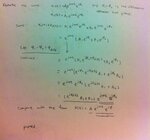drkirkby
Full Member level 6

If you have two sine waves with peak amplitdes V1 and V2, at the same frequency f, with an arbitrary phase difference between them, is the sum always a sine wave? Can anyone provide a proof or reference to this.
Dave
Dave





